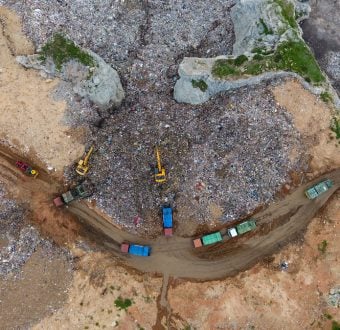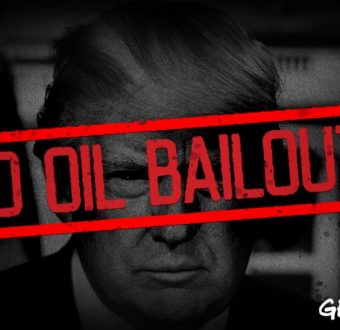Four lawsuits, a road blockade, and visits by Greenpeace’s ships, decorate the decades-long battle Greenpeace has endured to keep one of the last great wild spaces on the planet – the Tongass National Forest – safe for us and future generations.
The Tongass National Forest, at almost 17 million acres, is one of the largest undisturbed ecosystems in the US. Covering much of the Alaska panhandle in southeast Alaska, the Tongass is a land of old growth forests, mountains, glaciers and waterways home to Native Alaskans. It stores an incredible amount of carbon, and is filled with bountiful and unique wildlife.

Humpback whales breaching in the Tennakee Inlet in the Tongass National Forest.
Unfortunately this critical part of our natural heritage has come under constant attack from logging companies, other extractive industries, and the politicians in their pockets. As 2020 gears up to be a critical year for the Tongass, we are reflecting on the extraordinary lengths Greenpeace has gone for this rare temperate rainforest.
1. Blockade Action
In August 2004, 19 Greenpeace activists chained themselves to bulldozers and built road blockades in the Tongass National Forest to stand up against efforts by then President George W. Bush to remove Roadless Rule protections across the country. At the same time, the Greenpeace ship, the Arctic Sunrise, was in the salmon-rich waters off Prince of Wales Island to show the rest of the world this magnificent landscape at risk.

Greenpeace activists block a new road into formerly virgin forest near Petersburg in the Tongass National Forest.
In the final days of the Clinton Administration, the Roadless Rule was signed into law — granting protection to portions of our public lands not yet degraded by roads, logging, drilling and other commercial exploitation. However, from the moment the Roadless Rule was enacted, it has come under constant attack — especially for places like the Tongass.
2. Going to Court for the Roadless Rule
In 2005, Greenpeace, along with 19 other conservation organizations, sued the Bush Administration in order to reinstate the original Roadless Rule — a decade-old popular safeguard against logging and road building in previously untouched areas of our public lands and wilderness — instead of a much weaker states petition process he had put into place.
3. Stopping Destructive Timber Sales
In 2008, Greenpeace, along with Cascadia Wildlands, sued the US Forest Service over four timber sales in the Tongass that would have allowed 1,700 acres of old growth forest to be cleared. After a ten-year legal fight, the logging projects were permanently stopped over the Forest Service’s inadequate consideration of the detrimental environmental impacts the logging would have had on wildlife.

Timber Sale at Canal Hoya, Alaska.
4. Endangered Status for Alexander Archipelago Wolves
In 2014, Greenpeace, along with allies, sued the US Fish and Wildlife Service over delaying much needed protections under the Endangered Species Act for the incredibly rare Alexander Archipelago wolf, found exclusively in southeast Alaska. A long history of clear-cut logging on the Tongass and private and state-owned lands has devastated much of the wolf’s habitat. Unfortunately we lost that battle, so without protections and scientifically informed trapping quotas, a devastating numbers of wolves have been killed recently, placing the future of this species in grave peril.
5. Back in Court for the Roadless Rule
In 2017, Alaska’s latest attempt to remove Roadless Rule protections for the Tongass and all state wild lands was struck down in federal court after Greenpeace and several allies intervened in the case.
6. Your Voice for Intact Forests
In January 2020, Greenpeace helped a coalition-wide effort to deliver over 400,000 comments to the US Forest Service in opposition to the President Trump’s plan to repeal Roadless Rule protections across more than 9 million acres of the Tongass National Forest, opening the door to extractive industries to bulldoze roads and clear-cut trees in areas of the Tongass that have been off-limits for decades.

Roadbuilding is underway on the Midway sale, northwest of Tenakee Springs, Chichagof Island.
As we gear up to continue fighting for the Tongass in 2020, we are constantly reminded of the reasons why this national forest is so special and in need of protection. Ending the practice of old growth logging and leaving undisturbed places untouched would be a game changer for people and our planet. Old growth logging in the Tongass not only scars the landscape as it removes trees as old as 800 years, but it is bad for the local economy. It also destroys the forest’s ability to sequester carbon, house wildlife, and function for Native Alaskans.
Luckily, Greenpeace and allies have history on our side. Through so many legal challenges, destructive agency decisions, and toxic presidential actions aimed at undermining the Roadless Rule and the Tongass National Forest, Greenpeace and allies have been there. We know the months ahead will pose new challenges, that polluters and their allies in government will not quit, but with all of you by our side, we can assure you that we are not going anywhere.





